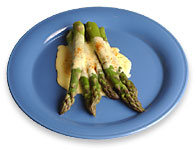|


emulsion at work
Hollandaise Sauce
Recipe:
Sometimes
eggs function as mediators. Try mixing oil and water, and
you'll get, well, oil and water. But with the addition of
an egg yolk, oil and water—or fat and water—can
blend together into a smooth mix.
In
hollandaise sauce, melted butter and water form a creamy mixture.
Tiny droplets of the butter are dispersed in the water, creating
a delicious combination. A chemist would call this an
emulsion.
A substance that helps two liquids remain in this state
is called an
emulsifier.
Egg yolks contain a number
of emulsifiers.
•
Why
are oil and water so difficult to mix—and how does
adding an egg yolk help?
There
are many different recipes for hollandaise—every chef
seems to have a variation of his or her own.
Recipe
Conversions
(
Note:
Recipe annotations will appear in a new window)
|
Makes
1 to 1 1/2 cups
Prep Time:
2 minutes |
Cook time:
8 minutes
|
|
|
|

|
|
What
Do I Need?
|
.
|
|
•
3 egg yolks
|
 Did
You Know?
Did
You Know?
Without the egg’s ability to join fat-based and water-based
liquids, we wouldn't have cake or mayonnaise or Caesar salad
dressing!
|
|
•
1 tablespoon lemon juice
|
|
•
1 tablespoon water
|
|
•
1/4 teaspoon salt
|
|
•
a pinch of white pepper
|
|
•
1 1/2 to 2 sticks (6–8 ounces) melted butter
|
|

|
 Tip
Tip
If you use a double boiler over hot (but not quite boiling)
water, you'll get a more even heat and reduce the possibility
of the eggs' coagulating. But this precaution comes with a price—you'll
have to whisk the mixture for a longer time.
|
|
•
a
wire whisk
|
|
•
a medium-weight stainless steel, enameled, or glass saucepan,
or a double boiler
•
Why
does the kind of saucepan matter?
|
|
|
|
|
What
Do I Do
?
|
|
|
1.
Put the egg yolks in the pan and beat them with a wire
whisk for a minute or two until they are slightly thickened.
|
|
|
|
|
2.
Beat in the lemon juice, water, salt, and pepper until
they are well combined.
|
|
|
|
|
3.
Place the pan over
low
heat and stir the mixture
with the wire whisk until it becomes smooth, creamy, and thicker.
You’ve now created the initial emulsion.
•
Why
do I have to keep the heat low?
|
 Tip
Tip
Remove
the pan from the heat occasionally to keep the mixture from
cooking too quickly.
|
|
|
|
|
4.
Remove the pan from the heat. Begin adding the melted
butter by no more than a quarter teaspoon at a time, quickly
beating in each addition before you add the next. Make sure
you scrape the mixture from the sides and bottom of the pan.
When the sauce is as thick as heavy cream, you may beat in
the butter by half tablespoons. It takes about 5 minutes to
create the final emulsion.
•
Why
do I have to keep whisking? Why can't I just dump all the
butter in at once?
|
 Did
You Know?
Did
You Know?
This rich sauce is perhaps best known as a companion to the
poached egg in the classic Eggs Benedict. It is often poured
over asparagus and other green vegetables as well.
|
|
|
|
|
5.
Serve at once—or keep the sauce warm by setting it
over a pan of lukewarm water. Hollandaise is served warm,
not hot.
•
Can
curdled hollandaise sauce be saved?
|
|
